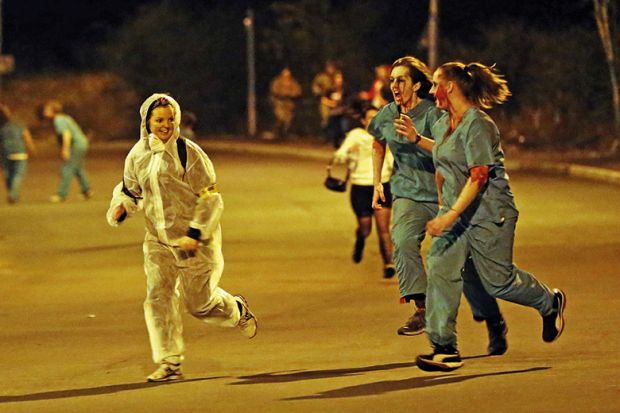It is fair to say that zombies are pretty much everywhere in the 21st century. They serve as the anonymous antagonists and the terrifying (or sometimes comedic) backdrop to countless films, television shows, video games, books and comics. They feature as components of branding on packaging and in logos, and appear in live-action games (2.8 Hours Later was a role-playing survival game where participants outrun or hide from other zombie players in deserted shopping malls (pictured)). And there have been zombie walks in many cities, with reports of tens of thousands of people dressing up and participating in some of the larger events.
The word “zombie” originates in a dark sect of the Haitian voodoo religion when a bokor or sorcerer removes and traps a person’s soul in a bottle, leaving the mindless body or zombi under the bokor ’s control. However, our contemporary understanding of the zombie – a reanimated corpse that seeks to devour our brains and other organs – really emerges with George A. Romero’s 1968 film, Night of the Living Dead. In this hammy but classic horror, Romero introduced the now familiar trope of a group of protagonists struggling (and often failing) to survive against a backdrop of an unexplained plague of the living dead.
Across different stories, the zombie plague or apocalypse is attributed to a variety of sources. Creation myths involve escaped biological warfare agents (the films 28 Days Later and 28 Weeks Later and the Resident Evil games and films); an accidentally opened plague pit (the book Zombie Apocalypse!); a chemical spill (the film Hell of the Living Dead); the bite of a Sumatran rat-monkey (the film Braindead); or a never fully explained but virally induced general tendency to become a zombie after death as long as the victim’s brain is whole (the Walking Dead comic and TV series). Central to such creation myths is the idea that once the initial zombie infection has begun, it spreads faster and more easily than it can be prevented, cured or stopped.
It is the value of such stories to our understanding of our place in – and the nature of – the contemporary world that Greg Garrett’s accessible volume focuses on. Based primarily on a theological approach, the central thrust of the book is that the popularity of zombies can be attributed to a society-wide attempt to grapple with a sense of threat or risk. This can be directly human (in the form of terrorism), an unintended consequence of human action (such as global warming) or a natural danger (such as earthquake or plague).
The motif of the dead rising as a response to social fears is detectable in many historical periods. It should be understood as both a symptom of threat or risk and an ameliorating device we use to assuage threat and risk. Accordingly, the value of contemporary zombie texts, be they films, books, comics or games, lies in how survivors deal with the zombie apocalypse and the discussion of the moral decisions entailed in surviving the brutal conditions described.
Marcus Leaning is senior fellow in media and information literacy, University of Winchester.
Living with the Living Dead: The Wisdom of the Zombie Apocalypse
By Greg Garrett
Oxford University Press, 272pp, £16.99
ISBN 9780190260453
Published 27 July 2017
后记
Print headline: Scared stiff by walking corpses




